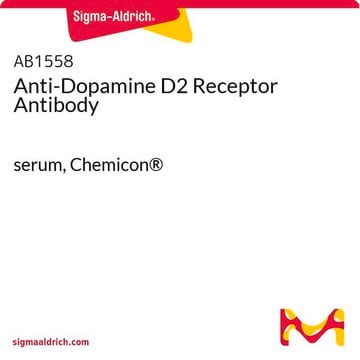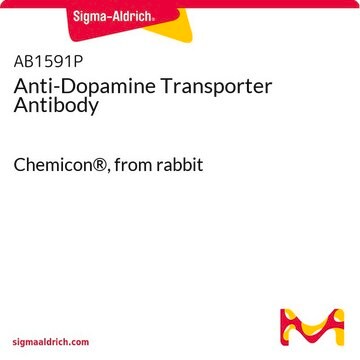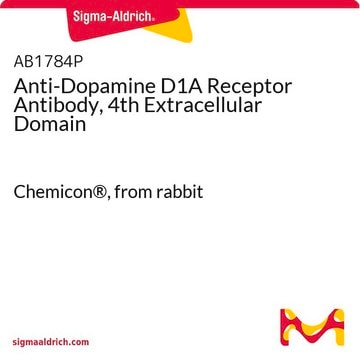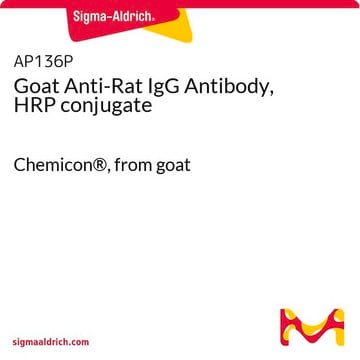MAB5292
Anti-Dopamine D1B Receptor Antibody, clone SG4-D1B
clone SG4-D1B, Chemicon®, from mouse
Synonyme(s) :
Dopamine D5 Receptor
About This Item
Produits recommandés
Source biologique
mouse
Forme d'anticorps
purified immunoglobulin
Type de produit anticorps
primary antibodies
Clone
SG4-D1B, monoclonal
Espèces réactives
mouse, rat
Ne doit pas réagir avec
human
Fabricant/nom de marque
Chemicon®
Technique(s)
immunohistochemistry: suitable
western blot: suitable
Isotype
IgG1
Numéro d'accès NCBI
Numéro d'accès UniProt
Conditions d'expédition
wet ice
Modification post-traductionnelle de la cible
unmodified
Informations sur le gène
human ... DRD5(1816)
Spécificité
Immunogène
Application
Neuroscience
Neurotransmitters & Receptors
Immunohistochemistry
Optimal working dilutions must be determined by the end user.
SUGGESTED WESTERN BLOT PROTOCOL
Solutions
10X Transfer buffer 1 liter
Tris 115.3 gm
Glycine 24.2 gm
[SDS 4 gm (may be omitted)]
For a 1X working solution: 1 liter
mix 700 mL water
200 mL
MeOH100 mL
10X Transfer
TBSTstock 1 liter1M
Tris pH 7.5 10 mL
5 M NaCl 30 mL
10% Tween-20 5 Ml
1. Run SDS-PAGE gel as desired.
2. Soak PVDF membrane (ImmobilonP from Millipore) in 100% methanol for 1-2 minutes to wet the membrane.
3. Soak membrane in transfer buffer (see below) until ready to set up blot (>15 min) transfer.
4. Assemble gel-transfer sandwich with the blot toward the positive electrode.
5. Transfer protein from gel to membrane at 100 volts for 1-2 hours for small molecular weight proteins or 65 mA for 16 hours (overnight) for complete transfer of higher molecular weight proteins.
6. Stain the transferred bands with Chemicon BLOT-FastStain (Catalog Number 2076).
7. Destain with deionized water.
8. Block with 5% non-fat milk (Marvel or Carnation) in water, overnight at 4°C. The non-fat milk should be dissolved freshly, centrifuged 10,000 rpm for 10 min, and filtered through glass filter (Gelman Acrodisc).
9. Incubation with first antibody overnight with rocking at 4°C in blocking solution. Optimal working dilutions and incubation time will need to be determined by the end user.
10. Wash at least 3 x 5 min. with TBST. From this stage, azide should be omitted.
11. Incubation with the secondary antibody (HRP-conjugated goat anti-mouse antibody, for example Chemicon Catalog Number AP124P, diluted appropriately) 1 h at room temperature.
12. Wash at least 3 x 5 min. with TBST.
13. Perform ECL with commercial kit (femtoLUCENT, Chemicon Catalog Number 2078).
Liaison
Forme physique
Stockage et stabilité
Autres remarques
Informations légales
Clause de non-responsabilité
Vous ne trouvez pas le bon produit ?
Essayez notre Outil de sélection de produits.
Code de la classe de stockage
10 - Combustible liquids
Classe de danger pour l'eau (WGK)
WGK 2
Point d'éclair (°F)
Not applicable
Point d'éclair (°C)
Not applicable
Certificats d'analyse (COA)
Recherchez un Certificats d'analyse (COA) en saisissant le numéro de lot du produit. Les numéros de lot figurent sur l'étiquette du produit après les mots "Lot" ou "Batch".
Déjà en possession de ce produit ?
Retrouvez la documentation relative aux produits que vous avez récemment achetés dans la Bibliothèque de documents.
Notre équipe de scientifiques dispose d'une expérience dans tous les secteurs de la recherche, notamment en sciences de la vie, science des matériaux, synthèse chimique, chromatographie, analyse et dans de nombreux autres domaines..
Contacter notre Service technique








